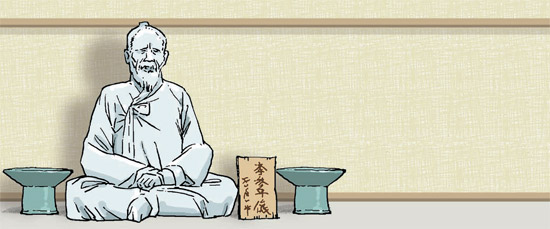Korean pottery thriving in Japan

Yun Seon-do (1587-1671) wrote this poem in 1616 when he was 29. He was in exile in Gyeongwon, Hamgyeong Province at the time. All he could see were endless mountains and rivers, and he missed his parents greatly. His poem reflects his love for his parents and loneliness during his exile.
In 1616, in the Saga Prefecture of northern Kyushu, Japan, a serious event took place. Potter Yi Sam-pyeong from Joseon discovered quality kaolin clay in Izumiyama, Arita, and baked the first white pottery in Japan. It became the origin of the world-famous Arita porcelain. I visited Saga Prefecture for a weekend trip, and the first thing I found in Arita Station was a sign that read, “2016 is the 400th anniversary of the Japanese porcelain industry.”
When I told a tour guide at the station that I was from Korea, he said, “Master Yi Sam-pyeong is the savior of the people of Arita!” I had mixed feelings and couldn’t bring myself to say, “In fact, your ancestors abducted the master.” The two invasions by Japan in 1592 and 1597 are also called “wars of pottery” as Japan abducted so many potters from Korea. They transferred the porcelain culture to Japan and played a pioneering role in creating the Japanese pottery boom in Europe.
I took Myongji University professor Yoo Hong-joon’s “Essays on Visits to Cultural Sites in Japan” with me, and the book helped me throughout the journey. You see what you know, indeed. After reading the book, I visited the Izumiyama Kaolin Mine, a memorial of Yi Sam-pyeong and Touzan Jinja, a shrine to Yi Sam-pyeong. Thanks to the book, I made a point to look for the haiku poem by Matsuo Basho (1644-1694) on a plaque in the shrine, which reads, “Enjoying the moon that lets you relax along the clouds.”
However, Yun Seon-do’s poem for his parents would be more appropriate than Basho’s haiku to be placed below the memorial for Yi Sam-pyeong at the shrine for the pottery master. In the same year that the poem was composed, Yi Sam-pyeong discovered the clay after missing his hometown and family for so long.
I felt frustrated. There must have been more Korean potters who were saved from abduction, but the Korean pottery industry did not develop further or gain an international reputation. It is regrettable that the techniques were not transferred to future generations. Also, a bitter question remains. Do we remember any of the potters who stayed in Korea?
The author is an editorial writer of the JoongAng Ilbo.
by NOH JAE-HYUN
‘뫼흔 길고 길고 물은 멀고 멀고 / 어버이 그린 뜻은 많고 많고 하고 하고 / 어디서 외기러기는 울고 울고 가느니.’ 고산 윤선도(1587~1671)가 이 시조를 지은 것은 1616년, 29세 때였다. 함경도 경원에 유배되었을 때의 작품이다. 산과 물은 끝없이 이어져 있고, 부모님에 대한 그리움은 헤아릴 수 없이 많다. 유배지에서의 회한과 효심이 절절하다. 같은 시기, 눈을 일본으로 돌려보면 1616년 규슈 북쪽 사가(佐賀)현에서 엄청난 일이 벌어진다. 조선 출신 도공 이삼평이 아리타(有田) 지방의 이즈미야마(泉山)에서 양질의 고령토를 발견해 일본 최초의 백자를 구워낸 것이다. 세계적으로 유명한 아리타 자기의 효시다. 지난 주말 사가현 기차 여행길에 아리타역에 내렸을 때 처음 마주친 것은 ‘2016년은 일본 자기산업 400주년이 되는 해입니다’라는 플래카드였다. 아리타역의 관광안내원은 내가 한국인이라 하자 대뜸 “이삼평 선생은 우리 아리타 주민의 은인입니다!”라고 외쳤다. 기분이 묘했다. 그 밝고 친절한 표정에 대고 ‘이삼평이 사실은 당신네 선조들이 납치해간 거 아니냐’는 말을 꺼내기는 어려웠다. 임진왜란·정유재란은 ‘도자기 전쟁’이라 불릴 정도로 일본군 측이 수많은 조선 도공을 다투어 끌고 간 전쟁이었다. 그들이 도자기 문화를 일본에 전파했고, 유럽에 일본 도자기 붐을 일으키는 선구자 역할을 했다. 나는 아리타 여행길에 가져간 유홍준 명지대 교수의 저서 『나의 문화유산 답사기-일본편』의 덕을 톡톡히 보았다. 역시 ‘아는만큼 보인다’는 말이 맞다. 책을 미리 읽었기에 이즈미야마의 거대한 자석장(磁石場) 터와 도조(陶祖) 이삼평 기념비, 이삼평을 신으로 모시고 있는 도산신사(陶山神社) 등을 흥미롭게 둘러볼 수 있었다. 도산신사 경내에서 도판에 새겨진 마쓰오 바쇼(1644~1694)의 하이쿠(俳句) 작품을 보게 된 것도 유 교수의 책 덕분이었다. ‘구름 따라서 / 사람을 쉬게 하는 / 달맞이런가’. 그러나 적어도 이삼평 기념비 바로 아래 위치하고 이삼평을 신으로 모신 장소라면, 바쇼의 담담한 하이쿠보다는 부모에 대한 진한 그리움을 담은 윤선도의 시조가 어울리지 않을까 싶었다. 시조를 지은 해와 이삼평이 향수를 억누르며 오랜 세월 헤매다 자석광을 발견한 해가 맞아떨어지기도 하니까. 한편으로 답답함이 밀려왔다. 왜란 때 일본에 끌려가지 않은 도공이 조선 땅에 훨씬 많이 있었을 텐데, 왜 조선의 도자기 산업은 더 발전하지 못하고 세계적인 명성을 얻지도 못했는지, 후손에 제대로 전수되지도 못했는지 조상들이 원망스러운 생각도 들었다. 착잡한 질문을 던지게 된다. 당시 조선에 남은 수많은 도공 중 우리가 기억하는 이가 과연 한 명이라도 있는가. 노재현 논설위원










with the Korea JoongAng Daily
To write comments, please log in to one of the accounts.
Standards Board Policy (0/250자)